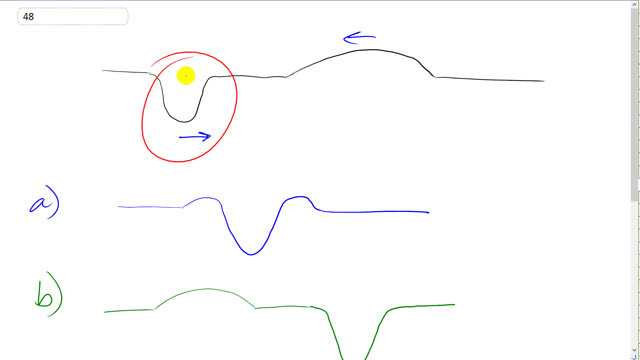
The two pulses shown in Fig. 11–54 are moving toward each other.
- Sketch the shape of the string at the moment they directly overlap.
- Sketch the shape of the string a few moments later.
- In Fig. 11–37a, at the moment the pulses pass each other, the string is straight. What has happened to the energy at this moment?

- see video
- see video
- It is all kinetic energy

In order to watch this solution you need to have a subscription.
This is Giancoli Answers with Mr. Dychko. These 2 pulses are coming towards each other. And this is a fairly small amplitude but wide pulse going to the left. And this is a large amplitude is really fair down but it's a narrow pulse going to the right. Now, when they superimpose perfectly, so they're right on top of each other. We'll have some little shoulders here because this wave is really wide and so these parts will be unaffected by the presence of this wave because they extend beyond the width of this wave here. So, this wave when they superimpose will be in like this. And that's where the shoulders come from. And then this part will go and go down below the midline because this wave is lower than this wave is high. So, you know, this might have a height of 1 unit and this might have a height of negative 2 units in which case this result would be height of negative 1 negative 2 plus 1, making negative 1, that's the idea. So, that's what happens when they superimpose perfectly. Now, sometime later, they're gonna carry on going in the direction they were here. So, this wide pulse will continue going to the left. And so here it is and it's still moving left. And then this pulse is moving to the right and they're, you know, within the limits of my ability to draw, these are identical. So, this is the same as this, has just moved its position to the left now. This wave is this or this pulse is the same as this pulse and is moving to the right and it's over here now. Their appearance is unaffected by the fact that they were previously on top of each other. So, the fact that they do some superposition at some point. Doesn't alter the pulse after they're finally away from each other. And then part c says, consider pulses like this that are identical moving in opposite directions, what happens when they superimpose and make the string just straight, and where is the energy? And the answer is, it's all kinetic energy. And there's no potential energy, because potential energy results from the string being stretched from its equilibrium position. And there's no stretching happening here there's no, you know, there's no spring action here, there's no elasticity here, there's no elastic potential energy. So, because it's totally unstretched that means there's no potential energy. There is kinetic energy because sometime later we'll see this pulse appear over here, and this pulse will appear over here. And so things are moving. There just happens to be no displacement at this particular instant in time.